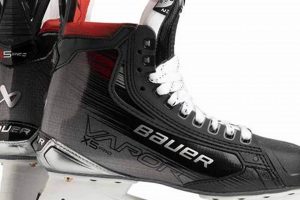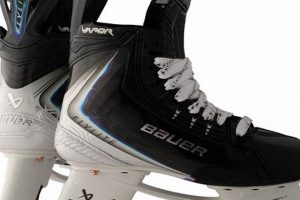A frozen recreational surface created in a residential outdoor space for the purpose of ice skating. This typically involves constructing a contained area and flooding it with water, allowing the water to freeze into a sheet of ice suitable for skating activities.
The provision of a personal skating area offers convenience, enabling users to engage in the sport or activity at their leisure, without the constraints of public rink schedules or travel. Historically, such setups have provided families and individuals with accessible winter recreation, fostering physical activity and social interaction during colder months. The controlled environment allows for personalized maintenance, potentially extending the skating season based on local weather conditions and construction methods.
The following sections will delve into the construction process, necessary materials, maintenance techniques, and safety considerations associated with creating and maintaining a dedicated space for winter ice recreation.
Essential Guidance for a Home Ice Surface
The creation of a successful frozen surface demands careful planning and consistent execution. The following guidance provides crucial considerations for optimizing the process.
Tip 1: Site Selection is Paramount: Prioritize a level area to ensure uniform ice thickness and minimize water pooling. Correct any significant slopes before construction begins, otherwise ice will freeze unevenly.
Tip 2: Liner Integrity is Crucial: Select a robust, impermeable liner material. Securely overlap and seal all seams to prevent water leakage and potential damage to the underlying surface. Consider a UV-resistant liner for extended lifespan.
Tip 3: Frame Construction Should Be Sturdy: The perimeter frame must withstand the outward pressure of the water as it freezes. Utilize durable materials and ensure proper bracing to prevent bowing or collapse, leading to a ruined rink.
Tip 4: Controlled Flooding is Recommended: Apply water in thin, incremental layers, allowing each layer to freeze completely before adding another. This method minimizes stress on the liner and promotes a smoother, more uniform ice surface. Avoid flooding in warm temperatures.
Tip 5: Consistent Maintenance is Mandatory: Regularly clear snow and debris to maintain ice quality. Periodically resurface the ice using a flooding technique to fill in cracks and imperfections. Consistent care prevents surface degradation.
Tip 6: Monitor Weather Conditions Closely: Track temperature fluctuations and adjust maintenance strategies accordingly. Prolonged periods of above-freezing temperatures necessitate increased monitoring and potential mitigation measures to preserve the frozen surface.
Tip 7: Prioritize Safety Measures: Implement appropriate safety precautions, including clear signage and perimeter barriers. Supervise skating activities, particularly those involving children. Be aware of ice thickness and conditions to prevent accidents.
Adhering to these principles helps guarantee a safe and enjoyable skating experience throughout the winter months. A well-constructed and maintained ice surface yields numerous opportunities for recreation and physical activity.
Subsequent sections will address advanced construction techniques and alternative maintenance strategies for optimizing the performance of the frozen surface.
1. Site Levelness
The topography of the chosen location exerts a direct and significant influence on the construction and performance of a frozen recreational surface. Deviations from a perfectly horizontal plane introduce uneven ice thickness, creating both safety hazards and functional limitations for skating activities. The absence of proper site leveling can lead to localized areas of thin or absent ice, increasing the risk of breakthroughs and injuries. Conversely, lower-lying areas will accumulate disproportionately more water, potentially exceeding the structural capacity of the containment system or prolonging the freezing process.
For instance, a backyard with a noticeable slope will require significantly more water to achieve a usable ice surface. The deeper water layer at the lower end of the slope will take longer to freeze, extending the overall construction timeline and potentially delaying the start of the skating season. This differential freezing can also induce stress on the liner, increasing the likelihood of tears or punctures. Furthermore, the uneven ice thickness directly impacts the skating experience, resulting in inconsistent glide and unpredictable skating conditions.
In summary, achieving and maintaining a level site is a fundamental prerequisite for a viable frozen recreational surface. Proper site preparation minimizes water consumption, promotes uniform freezing, reduces the risk of structural failure, enhances user safety, and optimizes the overall skating experience. Addressing topographical irregularities before construction commences is an essential investment that directly contributes to the long-term success of a backyard ice installment.
2. Liner Integrity
Liner integrity constitutes a foundational element in the successful construction and sustained functionality of any recreational frozen surface. It directly governs the water retention capabilities of the installation and, by extension, its ability to establish and maintain a suitable ice sheet for skating. Compromised liner integrity leads to water loss, structural instability, and ultimately, the failure of the recreational surface.
- Material Selection
The choice of liner material directly impacts its resistance to punctures, tears, and degradation from UV exposure and temperature fluctuations. Reinforced polyethylene offers a balance of durability and cost-effectiveness, while thicker, more specialized materials provide enhanced protection in demanding environments. Inadequate material selection results in premature liner failure and necessitates costly repairs or replacement.
- Seam Construction
The seams connecting individual liner sections represent potential points of weakness. Improperly sealed or inadequately overlapped seams are susceptible to leakage, particularly under the hydrostatic pressure exerted by the water. Utilizing appropriate sealing techniques and robust adhesives, or employing heat-welded seams, mitigates this risk and ensures a watertight barrier.
- Substrate Preparation
The underlying ground surface must be free of sharp objects, rocks, and debris that could compromise the liners integrity. Proper site preparation, including the removal of potential hazards and the application of a protective underlayment, reduces the risk of punctures and prolongs the liners lifespan. Neglecting this step increases the vulnerability of the liner to damage during the filling and freezing process.
- Environmental Factors
Exposure to extreme temperatures, sunlight, and chemical substances can accelerate the degradation of the liner material. Implementing protective measures, such as UV-resistant coatings or shading, minimizes the impact of these environmental factors and extends the liners operational lifespan. Regular inspection for signs of wear and tear allows for timely repairs and prevents catastrophic failures.
In conclusion, maintaining liner integrity is paramount for the successful creation and long-term viability of a frozen recreational surface. A robust and well-maintained liner ensures efficient water retention, structural stability, and a safe and enjoyable skating environment. Prioritizing proper material selection, seam construction, substrate preparation, and environmental protection is essential for maximizing the lifespan and performance of the frozen installation.
3. Frame Stability
Frame stability represents a critical structural element for a backyard ice surface. The frame serves as the containment boundary, preventing the outward expansion of water as it freezes and exerting significant force on the surrounding structure. Compromised frame integrity precipitates a cascade of negative consequences, impacting the safety, functionality, and longevity of the recreational ice area.
- Material Selection and Load Resistance
The selection of appropriate materials directly dictates the frames capacity to withstand the hydrostatic pressure exerted by the contained water. Untreated lumber, for instance, may lack the necessary strength and resistance to moisture, leading to warping, cracking, and eventual failure. Engineered lumber, reinforced plastics, or metal framing offer superior strength and durability, particularly for larger installations or those subjected to repeated freeze-thaw cycles. The load resistance of the frame must be carefully calculated based on the dimensions of the intended ice surface and the anticipated water depth.
- Joint Integrity and Connection Strength
The points where individual frame components connect represent potential weak points in the overall structure. Inadequate fastening methods, such as insufficient nailing or the use of inappropriate screws, compromise the integrity of these joints. Reinforced brackets, bolted connections, or interlocking framing systems provide superior stability and prevent separation under stress. Regular inspection and maintenance of these connections are crucial for identifying and addressing any signs of weakening or corrosion.
- Ground Support and Leveling
The stability of the frame is contingent upon a solid and level foundation. Uneven ground or inadequate support can induce stress concentrations within the frame, leading to localized failures or overall instability. Utilizing a level base, such as compacted gravel or adjustable supports, ensures uniform load distribution and prevents the frame from shifting or settling over time. Proper ground preparation minimizes the risk of structural damage and extends the lifespan of the ice area.
- Bracing and Reinforcement
Strategic bracing and reinforcement augment the frames ability to resist outward pressure and maintain its structural integrity. Diagonal bracing, cross-members, or external supports distribute the load more effectively and prevent bowing or collapse of the frame walls. The placement and configuration of these reinforcements should be carefully considered based on the overall design and anticipated stress patterns. Adequate bracing minimizes the risk of structural failure and ensures a safe and functional skating surface.
These facets of frame stability collectively contribute to the overall success of a backyard ice installation. Neglecting these considerations invites structural compromise, jeopardizing the integrity of the recreational area and potentially posing safety hazards. Prioritizing robust materials, secure connections, proper ground support, and strategic bracing ensures a stable and reliable frame, maximizing the lifespan and enjoyment of the ice surface.
4. Water Source
The availability and characteristics of the water supply are fundamental to the feasibility and maintenance of a recreational ice surface. The water source dictates the ease of initial creation, the potential for sustained operation, and, critically, the quality of the resulting ice sheet.
- Proximity and Volume Capacity
The distance of the water source from the designated area and its maximum flow rate directly impact the initial filling time. A readily accessible spigot with ample pressure significantly reduces the duration required to flood the area, minimizing the risk of premature freezing or water loss due to evaporation. Conversely, relying on distant sources or low-pressure systems can prolong the filling process, increasing labor and resource requirements. Example: A standard garden hose connected to a municipal water supply provides a practical option for many residential setups. The alternative, such as hauling water in containers, becomes increasingly impractical with larger surface areas.
- Water Quality and Impurities
The presence of dissolved minerals, organic matter, or sediment in the water supply directly affects the clarity and smoothness of the resulting ice. High concentrations of impurities can cause discoloration, uneven freezing patterns, and a rough, less desirable skating surface. Filtration systems or alternative water sources, such as collected rainwater (if sufficiently pure), may be necessary to mitigate these effects. Iron, for instance, often leads to staining of the ice.
- Water Temperature and Freezing Rate
The initial temperature of the water influences the speed at which the ice sheet forms. Utilizing colder water accelerates the freezing process, reducing the risk of melting during warm spells and minimizing the overall time required for the formation of a usable skating surface. Source water from a well, typically colder than surface water, may offer an advantage in certain climates.
- Cost and Sustainability Considerations
The financial implications of water usage, particularly when drawing from municipal supplies, represent a significant operational cost. Furthermore, responsible water management practices are essential for environmental sustainability. Exploring alternative sources, such as rainwater harvesting or greywater recycling (where permitted and treated appropriately), can reduce reliance on potable water and minimize the environmental impact of maintaining an ice surface. The economic and ecological factors warrant careful evaluation during the planning phase.
In summary, a strategic assessment of the water source is paramount for the creation of a viable and sustainable recreational ice installment. Optimizing for proximity, water quality, temperature, and cost-effectiveness ensures a functional and enjoyable winter activity. The connection between a suitable water supply and a backyard ice surface is inextricable, emphasizing the need for diligent planning and resource management.
5. Ice Maintenance
Ice maintenance is not merely an ancillary task but a fundamental determinant of the usability, safety, and longevity of any residential frozen surface intended for skating activities. Consistent and appropriate maintenance practices are indispensable for preserving ice quality and mitigating potential hazards.
- Snow Removal
Accumulated snowfall insulates the ice sheet, inhibiting further freezing and accelerating melting during periods of warmer temperatures. Moreover, snow introduces an uneven surface, detracting from the skating experience and increasing the risk of falls. Timely snow removal, using shovels, snow blowers, or specialized ice-clearing equipment, preserves the ice’s integrity and maintains a smooth skating surface. Example: Leaving a heavy snowfall on the ice during a brief thaw can create a slushy layer that refreezes into a rough, uneven surface, significantly diminishing its usability.
- Resurfacing Techniques
Regular skating activities generate imperfections on the ice surface, including ruts, cracks, and divots. Resurfacing, typically involving the application of a thin layer of water that freezes to fill these imperfections, restores a smooth and uniform skating area. This process can be achieved using a flooding technique with a hose or specialized ice resurfacing equipment. Example: The use of a drag-behind ice resurfacer, mimicking the function of a Zamboni on a smaller scale, provides a consistent and efficient means of repairing surface imperfections.
- Temperature Management
Monitoring and managing ice temperature are crucial for preventing excessive melting or cracking. During periods of warmer weather, shading the ice surface with tarps or reflective materials can reduce solar heat absorption. Conversely, allowing the ice to freeze more deeply during colder periods enhances its durability. Example: Deploying a white tarp over the area during a sunny day with temperatures slightly above freezing can significantly reduce melting and extend the skating season.
- Crack Repair and Structural Integrity
Cracks within the ice sheet can compromise its structural integrity and pose safety hazards. Prompt repair of cracks, using patching compounds or by carefully flooding the affected area, prevents further propagation and maintains a safe skating surface. Large or deep cracks may indicate underlying structural issues that require more extensive intervention. Example: Applying a slurry of ice and water into a crack, allowing it to freeze solid, effectively seals the fissure and restores the ice’s structural integrity.
These maintenance strategies are inextricably linked to the overall success of a backyard ice area. Neglecting these practices leads to a rapid degradation of ice quality, rendering the surface unusable and potentially dangerous. A proactive and diligent approach to ice maintenance ensures a prolonged skating season, a safe and enjoyable recreational experience, and the preservation of a valuable winter asset.
Frequently Asked Questions
The subsequent questions address common inquiries regarding the establishment and maintenance of recreational ice surfaces within residential settings.
Question 1: What is the optimal size for a backyard ice surface?
The optimal dimensions vary depending on available space and intended usage. A smaller surface (e.g., 20′ x 40′) suits casual skating or small children, whereas a larger surface (e.g., 40′ x 80′ or larger) accommodates hockey practice or more advanced skating activities. Careful consideration of spatial limitations is crucial.
Question 2: What is the minimum temperature required for ice formation?
Theoretically, ice can form at 32F (0C). However, consistent temperatures below freezing are necessary for sustained ice formation and maintenance. Fluctuating temperatures can lead to melting and a compromised ice surface. Prolonged periods below 25F (-4C) are ideal for rapid freezing and hardening.
Question 3: What type of liner is most suitable for this application?
Reinforced polyethylene (RPE) liners, typically 6-8 mil thick, provide a balance of durability, cost-effectiveness, and resistance to punctures. Thicker liners offer increased protection but may be more expensive. The liner must be impermeable to prevent water leakage and damage to the underlying ground.
Question 4: How does one prevent water leakage beneath the liner?
Thorough site preparation, including the removal of sharp objects and the application of a protective underlayment (e.g., sand or geotextile fabric), minimizes the risk of punctures. Securely overlapping and sealing all liner seams using appropriate adhesives or heat-welding techniques prevents water from seeping through the connections.
Question 5: What are the most effective methods for resurfacing the ice?
Applying thin layers of water to the existing ice surface, allowing each layer to freeze completely before adding another, is a proven resurfacing technique. This process fills in cracks and imperfections, restoring a smooth skating surface. Specialized ice resurfacing tools can streamline this process. Use warm water for best results.
Question 6: What safety precautions should be observed?
Constant monitoring of ice thickness is essential to prevent accidental breakthroughs. Supervising skating activities, particularly those involving children, is paramount. Implementing clear signage regarding potential hazards and restricting access to the ice surface when conditions are unsafe are crucial safety measures.
Adherence to these guidelines enhances the safety and enjoyment derived from a residential ice installation, confirming its viability as a seasonal recreational amenity.
Subsequent sections explore advanced techniques for optimizing surface quality and extending the operational lifespan of backyard ice facilities.
Conclusion
This exploration has illuminated critical facets of establishing and maintaining a functional backyard ice skate rink. From site selection and liner integrity to frame stability, water source management, and consistent maintenance, each element significantly impacts the viability and safety of the recreational ice surface. Understanding these foundational principles ensures a more controlled and predictable outcome for those considering this endeavor.
The successful implementation of a backyard ice skate rink represents more than mere recreation; it signifies a commitment to responsible resource management, meticulous planning, and adherence to safety protocols. It is incumbent upon those undertaking this project to prioritize these considerations, ensuring both the longevity of the installation and the well-being of its users. Careful adherence to the principles outlined herein will ultimately determine the success and sustainability of this seasonal amenity.







